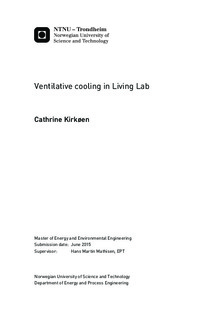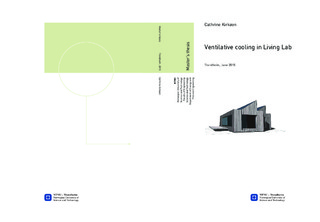| dc.description.abstract | This thesis is a study of ventilative cooling in super insulated residential buildings with focus on thermal comfort and energy use. The case of the study is Living Lab, an approximately 100m2 detached residential building designed with a mixed-mode ventilation system. The building is currently under construction at NTNU campus in Trondheim, Norway. The simulation software IDA ICE 4.6 has been used to study ventilative cooling in Living Lab. The results from the simulations have been compared to findings from previous studies. General conclusions on the applicability of ventilative cooling in low-energy dwellings have been drawn.
The results from the simulations imply that there will be a severe risk of overheating in Living Lab if no active or passive cooling techniques are applied. Moreover, the results show that ventilative cooling can prevent overheating without significantly increasing the energy demand. Due to the uncertainties related to increased air velocities, it is not possible to eliminate the risk of overcooling caused by ventilative cooling completely. However, the simulations show that overcooling can be held at an acceptable level. The factors most influencing the need for ventilative cooling in Living Lab are in the following order: solar radiation, outdoor temperature and occupancy. The simulations indicate that the openable window area is not a limiting factor for cooling. The study found that the best way to apply ventilative cooling in Living Lab is to implement a concurrent mixed-mode system where the window control system is only active during the day. This system should be designed to open the south and skylight windows to maximum opening when indoor air temperatures exceed 24C and close them when indoor air temperatures drops below 22C. Simulations reveal that this system would reduce the number of overheated hours recorded when not utilizing ventilative cooling with 99%. The number of overcooled hours was kept at a moderate level, 48 hours/year. This ventilative cooling system would increase energy demand with 52 kWh/year and 4 kWh/year compared to use of only hygienic mechanical ventilation and only enhanced mechanical ventilation, respectively.
This assignment and previous research show that overheating in low-energy dwellings is often an issue. It should therefore be addressed during the design process. Overheating in low-energy dwellings can be prevented with ventilative cooling. Ventilative cooling can have a significant positive effect on the thermal environment without having a significant negative effect on the use of energy. In some cases, energy consumption can even be reduced when applying ventilative cooling. Overcooling can be an issue when utilizing ventilative cooling. A careful design process is needed for ventilative cooling to have the desired effect. The process should be individual for each building and climate. A more complex natural ventilation system requires a more accurate and careful design process. Also, the acceptable indoor temperatures for mechanically ventilated buildings often have to be adjusted for buildings intended to utilize ventilative cooling. Even though nighttime ventilative cooling is not applicable in certain lightweight dwellings, it has proven to be effective in buildings with more thermal mass. An automatic window control system is often necessary for ventilative cooling to achieve the desired thermal environment. The occupants should, however, be able to overrule the automatic system. | |

